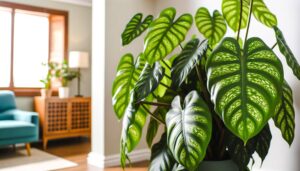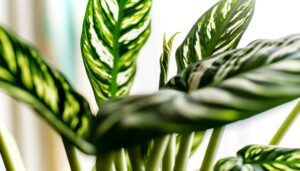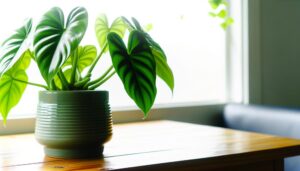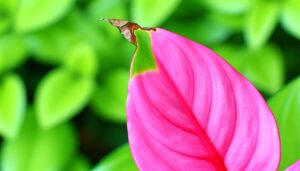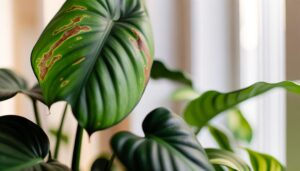What Are Common Problems With Philodendron Cordatum?
Philodendron cordatum frequently suffers from chlorosis, drooping stems, and brown leaf tips due to improper watering schedules, insufficient light, and nutrient deficiencies. Overwatering can result in root rot, leading to blackened and mushy roots.
Specific pests like aphids, spider mites, and mealybugs cause leaf yellowing and deformation. Additionally, fungal and bacterial pathogens may result in leaf spots with necrotic lesions or water-soaked halos.
Observational symptoms of overwatering include yellowing leaves and pathogenic fungal proliferation. Appropriate water management, light conditions, and balanced fertilization are essential to plant health.
Discover more insights into ideal care practices for a thriving Philodendron cordatum.
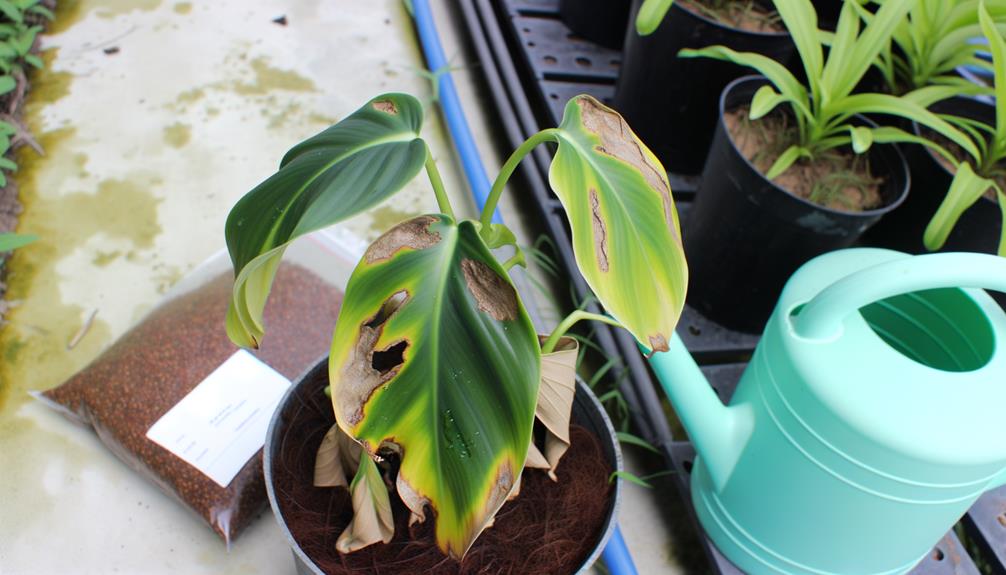
Key Takeaways
- Yellowing leaves indicate nutrient deficiencies, overwatering, or inadequate light.
- Drooping stems can result from overwatering, underwatering, or nutrient imbalances.
- Brown leaf tips often stem from inconsistent watering, low humidity, or micronutrient deficiencies.
- Root rot is caused by overly saturated soil and pathogenic fungi.
- Pests like aphids, spider mites, and mealybugs can cause leaf damage and weakened plant health.
Yellow Leaves

Observing yellow leaves on Philodendron cordatum often indicates underlying issues related to nutrient deficiencies, improper watering, or inadequate light conditions.
Chlorosis, the yellowing of leaf tissue due to insufficient chlorophyll, is a common symptom. This can result from a lack of essential nutrients such as nitrogen, iron, or magnesium.
Overwatering can lead to root hypoxia, impairing the plant's ability to absorb nutrients and causing leaf discoloration. Conversely, underwatering can induce stress, leading to similar symptoms.
Additionally, inadequate light exposure reduces photosynthetic efficiency, contributing to chlorotic leaves.
Monitoring soil moisture levels, ensuring balanced fertilization, and providing ideal light conditions are critical steps in diagnosing and correcting the causes of yellow leaves in Philodendron cordatum.
Drooping Stems
In addition to yellowing leaves, drooping stems in Philodendron cordatum often signal issues related to water stress, nutrient imbalance, or structural deficiencies within the plant's cellular framework. Water stress, both excessive watering and insufficient watering, disrupts turgor pressure within the plant cells, causing stems to lose rigidity. Nutrient imbalances, particularly deficiencies in nitrogen or potassium, can compromise stem strength and overall plant strength. Structural deficiencies, including insufficient light exposure, may hinder photosynthesis, weakening the plant's overall architecture.
| Concern | Impact on Stems |
|---|---|
| Excessive Watering | Cell turgor loss |
| Insufficient Watering | Dehydration stress |
| Nitrogen Deficiency | Weak stem growth |
| Potassium Deficiency | Reduced resilience |
| Insufficient Light | Photosynthesis drop |
Brown Leaf Tips
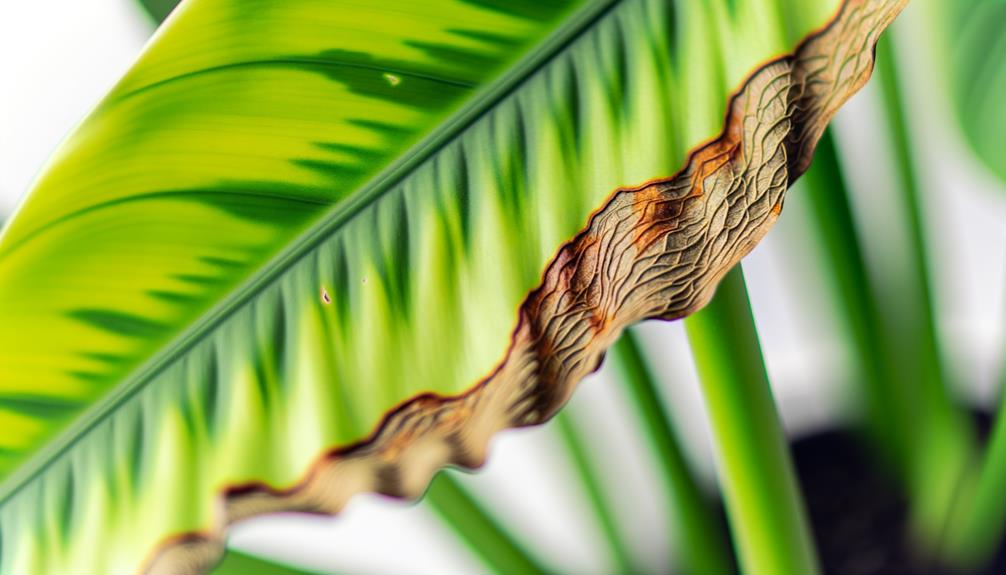
Brown leaf tips in Philodendron cordatum are frequently indicative of suboptimal environmental conditions or nutrient deficiencies affecting the plant's physiological processes. This symptom commonly arises from inconsistent watering practices, leading to either drought stress or waterlogged soil conditions.
Additionally, inadequate humidity levels can exacerbate desiccation at the leaf margins. Micronutrient deficiencies, particularly in potassium, magnesium, or calcium, often manifest as necrotic leaf tips due to impaired cellular function and nutrient transport.
Excessive accumulation of soluble salts from over-fertilization can also result in osmotic stress, damaging root systems and leading to browning tips. It is crucial to maintain a balanced watering regimen, guarantee appropriate humidity, and provide a well-rounded fertilization schedule to mitigate these physiological stresses.
Root Rot
Root rot in Philodendron cordatum typically results from pathogenic fungi thriving in overly saturated soil conditions, leading to the deterioration of root tissues and subsequent plant decline. The primary pathogens implicated are species of Pythium, Phytophthora, and Rhizoctonia.
Observations of affected plants reveal blackened, mushy roots, reduced water and nutrient uptake, and yellowing or wilting foliage.
To mitigate root rot:
- Ensure proper drainage: Utilize well-draining potting mix and containers with adequate drainage holes.
- Moderate watering practices: Allow the top inch of soil to dry out between waterings to prevent waterlogging.
- Implement fungicidal treatments: Apply broad-spectrum fungicides containing active ingredients like mefenoxam or thiophanate-methyl to control fungal proliferation.
Pests and Insects
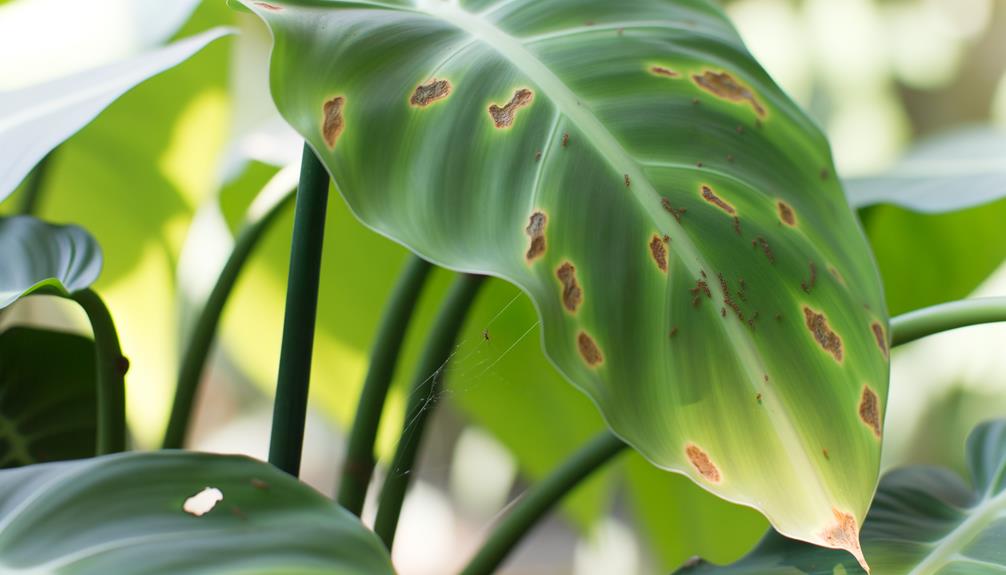
Philodendron cordatum is susceptible to a variety of pests, including aphids, spider mites, and mealybugs, which can cause significant damage to the plant's foliage and overall health. These pests feed on the plant's sap, leading to chlorosis, wilting, and stunted growth. Early detection and management are essential for maintaining plant vitality. Below is a table summarizing these pests:
| Pest | Symptoms |
|---|---|
| Aphids | Yellowing leaves, sticky residue |
| Spider Mites | Fine webbing, speckled leaves |
| Mealybugs | Cotton-like masses, leaf drop |
| Scale | Brown scales, honeydew secretion |
| Thrips | Silvery streaks, distorted growth |
Regular inspection, isolation of infected plants, and appropriate use of insecticidal soap or neem oil are recommended for pest control.
Slow Growth
Typically, slow growth in Philodendron cordatum can be attributed to less than ideal environmental conditions, including insufficient light, inadequate watering practices, and nutrient deficiencies. Key factors contributing to reduced growth rates include:
- Light Intensity: Philodendron cordatum requires bright, indirect light. Subpar lighting conditions, such as low light environments, impede photosynthetic efficiency, reducing growth rates.
- Watering Practices: Overwatering or underwatering disrupts the plant's metabolic processes. Consistent moisture levels, without waterlogging or drought stress, are essential for optimal growth.
- Nutrient Deficiencies: Essential macronutrients like nitrogen, phosphorus, and potassium are critical for plant growth. A lack of these nutrients in the soil can result in stunted growth, yellowing leaves, and weakened plant structure.
Addressing these factors can notably enhance the growth performance of Philodendron cordatum.
Leaf Spots
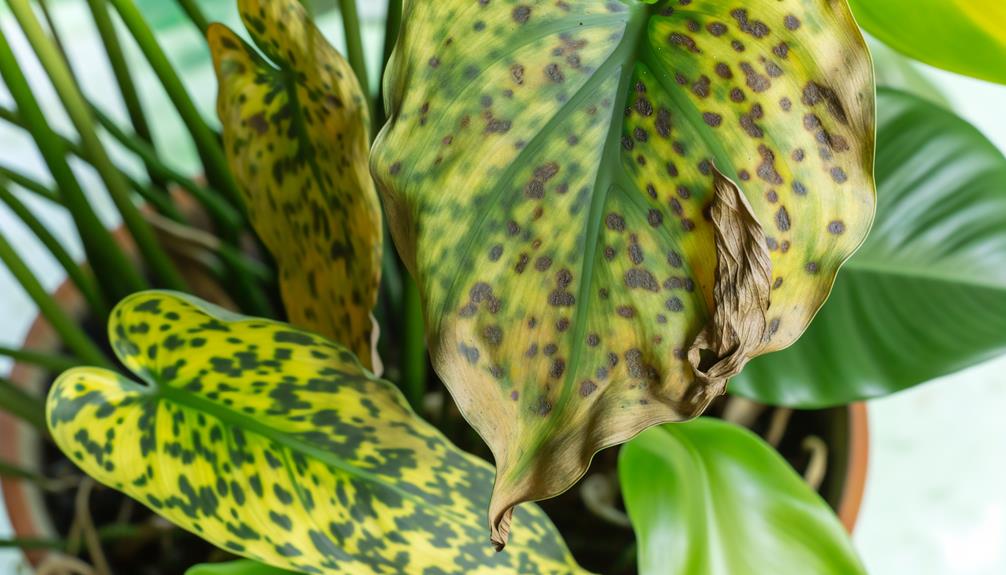
Leaf spots on Philodendron cordatum can manifest due to various biotic and abiotic factors, including fungal infections, bacterial pathogens, and environmental stressors.
Fungal infections, such as those caused by Phytophthora or Colletotrichum species, typically present as necrotic lesions with concentric rings. Bacterial pathogens, like Xanthomonas, lead to water-soaked spots that may exude a yellowish halo.
Environmental stressors, including suboptimal humidity and excessive light, can also induce chlorotic or necrotic spots on foliage. Accurate diagnosis often requires microscopic examination and culturing techniques.
Preventative measures include ensuring proper air circulation, maintaining appropriate humidity levels, and utilizing sterile tools. Prompt removal of affected leaves and application of fungicides or bactericides can mitigate spread, preserving plant health.
Overwatering
Overwatering is a prevalent issue in Philodendron cordatum cultivation, often resulting in root rot, characterized by brown, mushy roots due to anaerobic soil conditions.
This condition leads to the manifestation of chlorosis, observable as yellowing leaves, which signal impaired nutrient uptake.
Effective management includes precise irrigation practices and ensuring well-draining soil substrates to mitigate these symptoms.
Root Rot Issues
Root rot in Philodendron Cordatum, primarily induced by overwatering, manifests through the decomposition of root tissues due to prolonged exposure to excessive moisture. This pathological condition impairs the plant's ability to uptake essential nutrients and water, resulting in systemic decline.
Critical indicators of root rot include:
- Foul Odor: Decomposing roots emit a distinct, unpleasant smell, indicating anaerobic bacterial activity.
- Root Discoloration: Healthy roots appear white and firm, whereas affected roots turn brown or black and become mushy.
- Stunted Growth: The plant exhibits reduced vigor and slowed growth rates as the compromised root system fails to support normal physiological processes.
Mitigating root rot necessitates immediate intervention, such as improving drainage and reducing watering frequency, to restore homeostasis within the rhizosphere.
Yellowing Leaves Symptoms
Excessive water retention in the soil disturbs the physiological balance of Philodendron Cordatum, leading to chlorosis, where leaves exhibit yellowing due to impaired chlorophyll synthesis. Overwatering results in anaerobic soil conditions, adversely affecting root oxygen uptake and causing hypoxia. This stress condition hinders the root's ability to absorb essential nutrients such as nitrogen, magnesium, and iron, vital for chlorophyll production.
Observationally, yellowing typically initiates at the leaf margins before spreading inward. Additionally, waterlogged soils foster pathogenic fungi, further worsening root damage and subsequent nutrient transport disruptions.
To mitigate these symptoms, practitioners should ensure well-draining soil and appropriate watering intervals, thereby maintaining optimal aeration and root function, necessary for the plant's overall health and vigor.
Underwatering
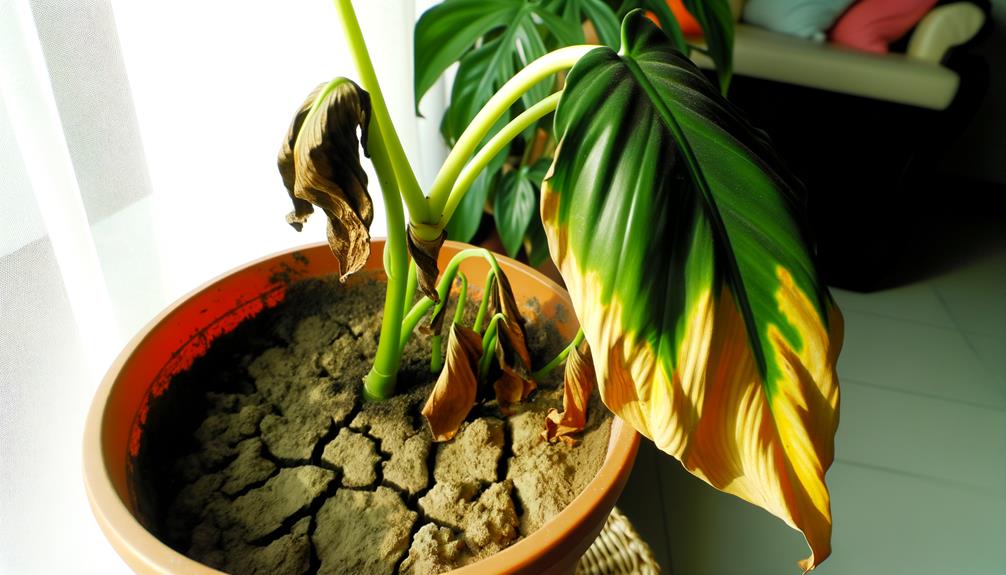
Underwatering in Philodendron cordatum manifests through distinct physiological symptoms such as:
- Leaf curling
- Browning edges
- Overall wilting, indicating cellular dehydration.
Ensuring ideal hydration involves adhering to a precise watering schedule that takes into consideration environmental variables such as:
- Humidity
- Temperature
- Soil moisture levels.
Implementing consistent monitoring and timely interventions can mitigate the adverse effects of water deficiency and promote robust plant health.
Signs of Dehydration
Wilting leaves, browning edges, and stunted growth are primary indicators of dehydration in Philodendron Cordatum, signaling insufficient water uptake. These symptoms arise due to a deficit in turgor pressure within the plant cells, impairing normal physiological functions.
Observations include:
- Leaf Curling: Leaves may curl inward or downward as the plant attempts to minimize water loss through transpiration.
- Crispy Leaf Margins: Browning and crisping at the leaf edges are indicative of cellular desiccation, leading to necrosis of the tissue.
- Slow Growth: Diminished elongation of stems and leaves results from inadequate hydration, which is important for cellular expansion and nutrient transport.
These signs necessitate prompt attention to restore the best hydration levels and guarantee the plant's continued health.
Watering Frequency Tips
Proper hydration of Philodendron Cordatum can be achieved by following a systematic watering schedule tailored to the plant's physiological needs and environmental conditions. Underwatering can result in symptoms such as leaf curling, browning edges, and stunted growth. Monitoring soil moisture and environmental humidity is crucial. The following table provides a guide to determine the best watering frequency:
| Condition | Frequency | Notes |
|---|---|---|
| High Humidity | Every 10-14 days | Soil should slightly dry out |
| Moderate Humidity | Every 7-10 days | Maintain steady moisture |
| Low Humidity | Every 5-7 days | Avoid complete dryness |
| Winter Season | Every 14-21 days | Reduced growth rate |
| Summer Season | Every 5-7 days | Increased evaporation rate |
Following these guidelines ensures a well-rounded hydration strategy, reducing the risk of underwatering.
Lack of Humidity
Insufficient ambient humidity can lead to physiological stress in Philodendron cordatum, manifesting as browning leaf edges and reduced overall vigor. This tropical species thrives in humidity levels of 60-80%, conditions often unmet in typical indoor environments.
To mitigate humidity-related issues, consider the following strategies:
- Utilize a Humidifier: Deploying a humidifier near the plant can maintain ideal moisture levels, preventing cellular dehydration.
- Pebble Trays: Placing the plant pot on a tray filled with water and pebbles elevates humidity through evaporation, without waterlogging the roots.
- Misting: Regularly misting the foliage with dechlorinated water can temporarily increase humidity, though it should be complemented with other measures for sustained effectiveness.
These interventions collectively enhance the plant's microenvironment, supporting its physiological needs.
Conclusion
To sum up, Philodendron cordatum displays a variety of issues like yellow leaves, drooping stems, and brown leaf tips, often signaling overwatering, underwatering, or nutrient imbalances. Pests and diseases, such as root rot and leaf spots, also add complexity to its care.
A watchful approach to humidity levels and watering practices is crucial. Since the plant's health depends on its surroundings, knowledge of these possible issues guarantees the essentiality and endurance of this species.


